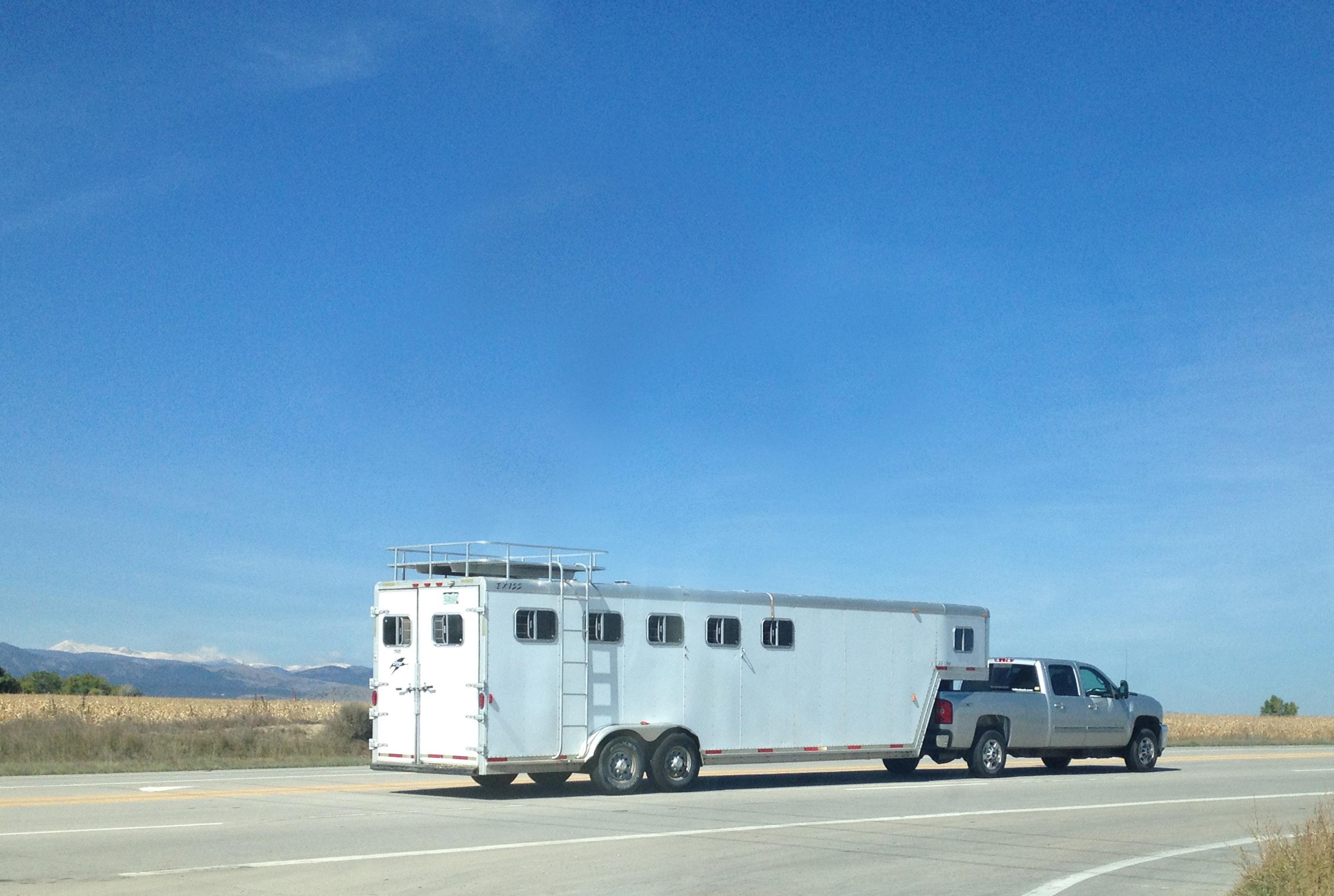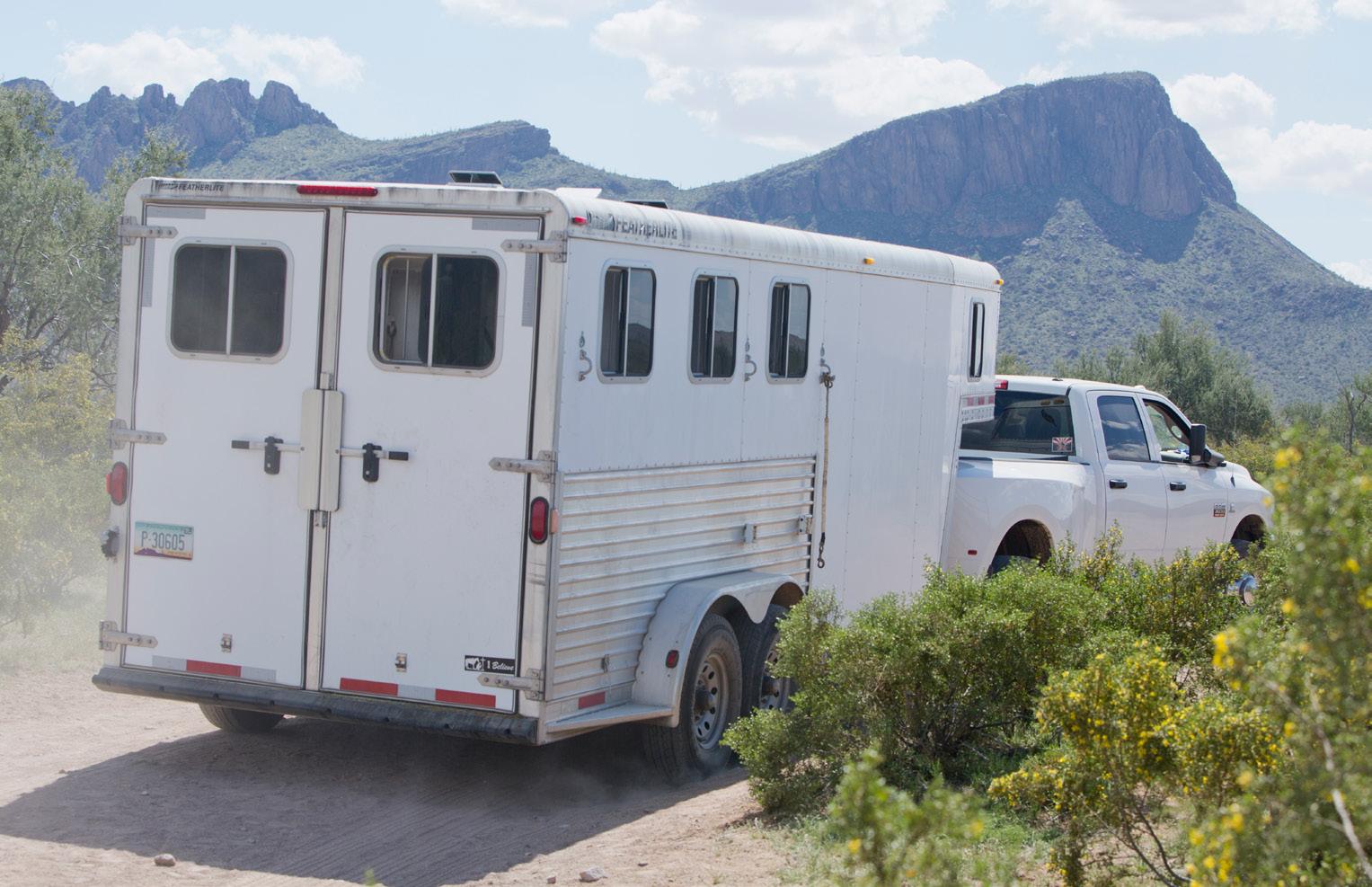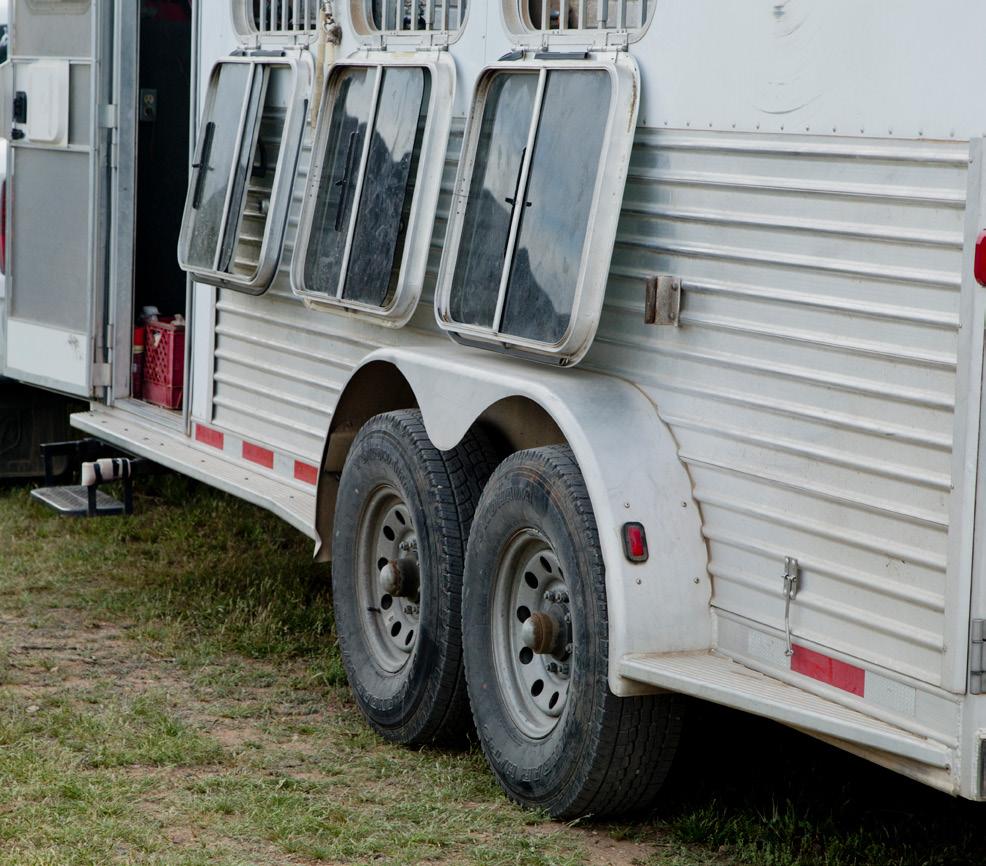
10 minute read
Hauling Hints
Learn how to prevent a trailer-tire blowout—and what to do if you experience a blowout despite your best efforts. Courtesy of USRider Photos by Heidi Melocco
Be aware of hitching weight. With a gooseneck, much of the weight is on the hitch and your tow vehicle’s rear axle. The amount of weight on the hitch can change significantly as the animals shift or after a tire blows out.
Trailer-tire blowouts are risky and stressful for both human and horse. And they can happen without warning. One minute, you’re sailing down the interstate, and the next, you hear a horrific “bam!” and your trailer pulls to one side. You grab the steering wheel to control your rig and look for a place to pull over. You glance in the rear-view mirror. A trailer tire has blown.
How well prepared you are for a blowout can lessen the severity of a blown tire’s impact. And steps you take today can prevent a blowout from happening in the first place.
Here, we’ll first give you 11 ways to prevent a blowout. Then we’ll give you a preventive-maintenance to-do list. Finally, we’ll tell you the steps to take should you experience a blowout despite your best efforts. (For how to change a trailer tire, click here.)
>> Blowout Prevention Here are 11 ways to help prevent trailer-tire blowouts. Invest in high-quality tires. Use high-quality trailer tires that are correctly rated for the weight you are hauling. Check your vehicle’s tow rating. The biggest contributor to turning a simple blown tire into a trailer accident is a
With a tag-along trailer, there’s less weight on the hitch than there is with a gooseneck, so the horses’ shifting weight can make the trailer sway.

mismatch between the size of the vehicle and the size and weight of the trailer. The weight, engine power, and torque of an appropriately sized vehicle will allow you to control and counteract trailer sway or vibration during blowout. Weigh your trailer. At a truck stop, weigh your loaded tow vehicle and trailer, then weigh just your tow vehicle, and subtract to get the weight of your trailer. It may surprise you how heavy your trailer is with all your stuff in it. Use the appropriate vehicle for the trailer to be towed. It’s better to oversize than undersize. Be aware of hitching weight. Gooseneck and tag-along (bumperpull) trailers differ in their hitching mechanisms. With a gooseneck, much of the weight is on the hitch and your tow vehicle’s rear axle. With a tag-along, there’s less weight on the hitch, so the horses’ shifting weight can make the trailer sway. The amount of weight on the hitch can change significantly as the animals shift or after a tire blows out. Check the trailer axles. Your trailer should have at least two axles. That way, if a tire fails, you’ll have the other to temporarily support the weight of the load. Check the safety chains. Safety chains should be as recommended by the manufacturer and strong enough to keep your trailer attached to your tow vehicle in case of a hitch uncoupling. Check the braking system. Your trailer’s emergency breakaway braking system should have a battery located on the nose of the hitch in a tag-along trailer or behind the nose of a gooseneck. Make sure there’s a cable from the switch to your tow vehicle, again attached to the frame. This cable is designed to lock the brakes on your trailer and stop it if the hitch and safety chains fail. Hitch up right. Cross the safety chains, and attach them to your tow vehicle’s frame or a manufactured receiver. Both gooseneck and tag-along trailers should have these chains in place so that your rig can survive the sudden weight shift of a blowout. Load up right. With a straightload trailer configuration, load a single horse into the left-hand stall to balance the weight on the crown of the road. Drive carefully. Drive the speed limit, maintain a safe distance from other vehicles, and be a defensive driver. Be aware of the position of other drivers. When possible, stay in the right lane so you’ll be able to quickly shift into the emergency lane. Turn with care. When you turn, take as much room as possible to prevent dragging a locked tire on pavement (especially with a gooseneck trailer) and scraping the sides of the tire along the curb.
Preventive Maintenance Truck-and-trailer maintenance can help prevent blowouts. Here’s a to-do list.

Keep a pressure gauge in your tow vehicle, and use it to check the air pressure in the tires whenever you stop.
Check tire condition. Regularly check the tires for appropriate tread depth and bubbles or misshapen areas on the surface and walls. Look for any evidence of the tire being cut or pierced by road debris. This is especially important if you use your trailer infrequently (less than once per month). Check tire pressure. Keep a pressure gauge in your tow vehicle, >>
and use it to check the air pressure in the tires whenever you stop. Tires should be inflated to the level of pressure recommended by the tire manufacturer. Some people put less than the recommended amount of air in the tires for a smoother ride, but this is never a good idea for trailers. Rotate the tires. Regularly rotate tires on your trailer and tow vehicle (every 5,000 miles of trailer usage, similar to recommendations for your vehicle). Consider an odometer. Consider putting a tire odometer on your trailer to keep track of the mileage between scheduled maintenance. Check wheel bearings. Make sure the wheel bearings are greased and packed. Maintain the braking system. Make sure the emergency breakaway braking system is in good working condition.
Regularly check the tires for appropriate tread depth and bubbles or misshapen areas on the surface and walls.

Maintain springs/axles. Make sure there are no broken springs or bent axles that would compromise your trailer’s integrity. Increase visibility. To increase your rig’s visibility in the event of a blowout, place reflective tape on
Check your vehicle’s tow rating. Your tow vehicle’s weight, engine power, and torque will allow you to control and counteract trailer sway or vibration during a blowout.

the back of your trailer, and make sure all lights are in good working condition.
Plan of Action If you do experience a blowout, you can maximize the safety of humans and horses—and minimize the damage to your trailer—with the following plan of action. (For how to change a trailer tire, click here.) Stop when you hear a noise. Don’t drive along and listen to strange sounds while trying to determine their cause. Stop expediently on the roadside whenever you hear or feel anything unusual (such as trailer rocking, excessive vibration, loud noises, and screeching or metallic sounds). Causes of a strange noise or unusual vibrations include a tire ready to blow, a fallen horse, a locked-up axle or wheel, or trapped road debris. Find a safe place to pull over. If you experience a blowout, find a place to pull over with plenty of room to change the tire. You’ll need a minimum of 12 feet from traffic lanes. Consider slowly limping your trailer to the next off ramp or a parking lot, particularly if it’s dark. While that may destroy the wheel rim, you’ll be able to safely deal with the situation without getting hit by other drivers. If the left-side tires are blown, pull your trailer as far off to the side of the road as possible. No one wants to get killed changing a tire so close to traffic lanes, which is a very real risk. Stop smoothly. Try to decelerate and brake smoothly until you come to a stop. While you’ll want to stop as soon as is safely possible and in as safe a position on the side of the roadway as you can, you don’t want to cause an accident by whipping over to the side or by losing control. Apply the parking brake. Apply the parking brake to make sure your rig doesn’t roll or accidentally move when you’re trying to asses the situation or change the tire. Turn on lights. Turn on the emergency flashers and working lights to warn oncoming drivers that your rig is stopped. The reflective tape will also enhance your visibility. Cut the engine. Turn off your tow
vehicle, and take the keys with you so no one moves your trailer while you’re waiting for help or working with the tire or jack. People have been seriously injured by vehicles rolling or falling on them while they were trying to help. Don a reflective vest. Don a reflective or brightly colored vest or jacket so you’ll be visible to oncoming traffic. Call 911. If there was an accident, call 911, and give the particulars. Chock the wheels. Secure the wheels with chocks so there’s no chance for your rig to roll. It’s best to use wheel chocks, but in a pinch, grab rocks or logs—whatever is available. Stay hitched. Don’t separate your trailer from your tow vehicle. Your tow vehicle is the best way to make sure your trailer stays put, especially when the emergency brake is on. Be aware that you need to stabilize your trailer with the weight of potentially upset horses on board. Check on the horses. Check on the horses through a window or opening. If a horse appears injured, call a local veterinarian immediately. USRider can help you find an emergency vet. Leave the trailer door closed. Any stimulation may cause the horses to get excited and try to back out or scramble. If the horses seem okay, consider giving them hay through a window or opening to help them relax while you’re fixing the tire or waiting for help to arrive. Call USRider. USRider Equestrian Motor Plan can arrange tire-changing and towing services for both your tow vehicle and trailer. Keep horses inside. Don’t unload the horses unless absolutely necessary and certainly not until help arrives. Unloading a horse on the side of the road is a very dangerous scenario. They may get loose and cause a secondary accident. USR Stop expediently whenever you hear or feel anything unusual. Causes of a strange noise or unusual vibration include a tire ready to blow, a fallen horse, a locked-up axle or wheel, or trapped road debris.

Perfect THE Perfect THE
WAY TO BUY AND SELL HORSES GUARANTEED SATISFACTION “Great site. Very user friendly, very honest about the AQHA verification. I will always use this site. Thank you for having such a great Web page.”
Zahl, North Dakota WAY TO BUY AND SELL HORSES GUARANTEED SATISFACTION “Great site. Very user friendly, very honest about the AQHA verification. I will always use this site. Thank you for having such a great Web page.”
Zahl, North Dakota


FOLLOW US: http://equine.com/ www.Facebook.com/equine.com @equine_com Equine.com is the fast and secure way to buy and sell horses, trailers and more. As one of the largest equine marketplaces, we sell an average of one horse every half hour. * The testimonial in this ad is an actual testimonial from Equine.com. The photo may not be a photo from the same ad as the testimonial. FOLLOW US: http://equine.com/ www.Facebook.com/equine.com @equine_com Equine.com is the fast and secure way to buy and sell horses, trailers and more. As one of the largest equine marketplaces, we sell an average of one horse every half hour. * The testimonial in this ad is an actual testimonial from Equine.com. The photo may not be a photo from the same ad as the testimonial.










